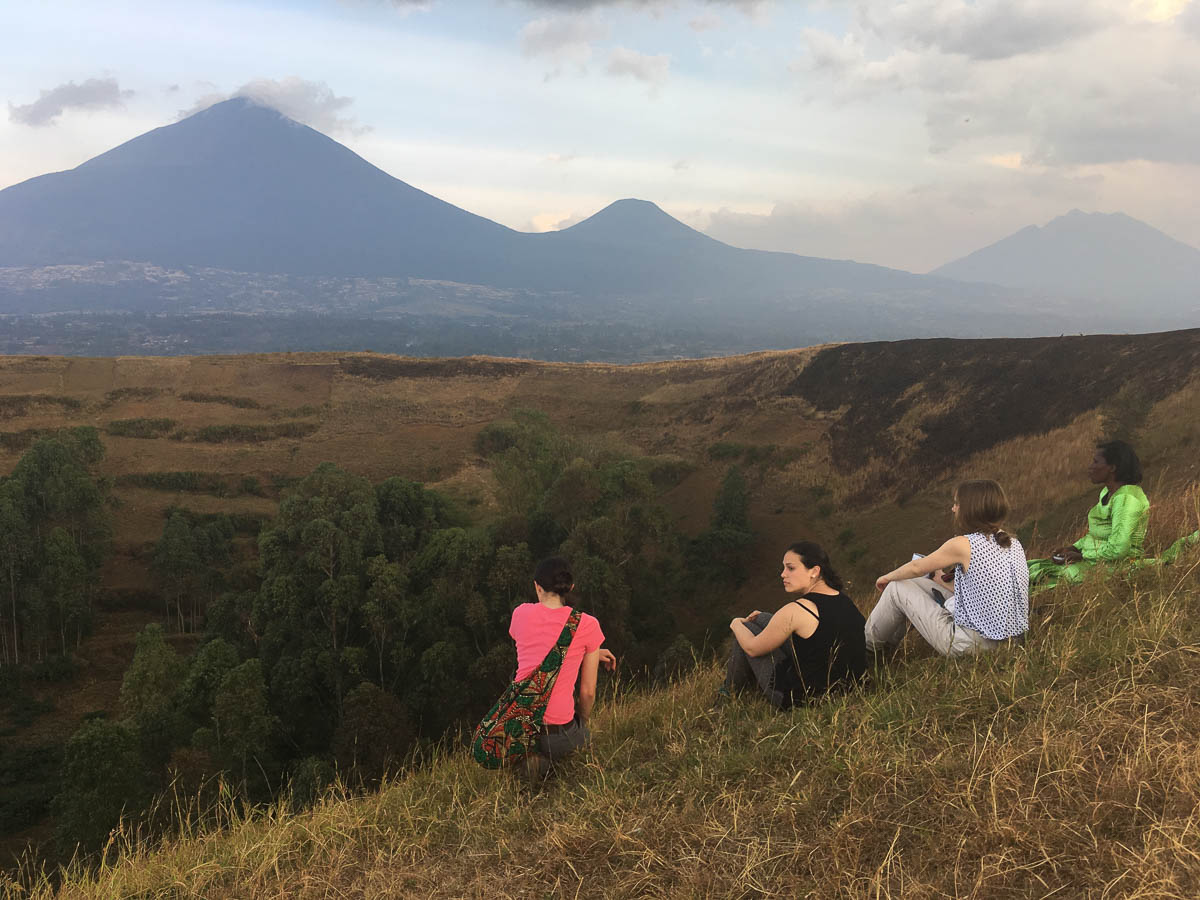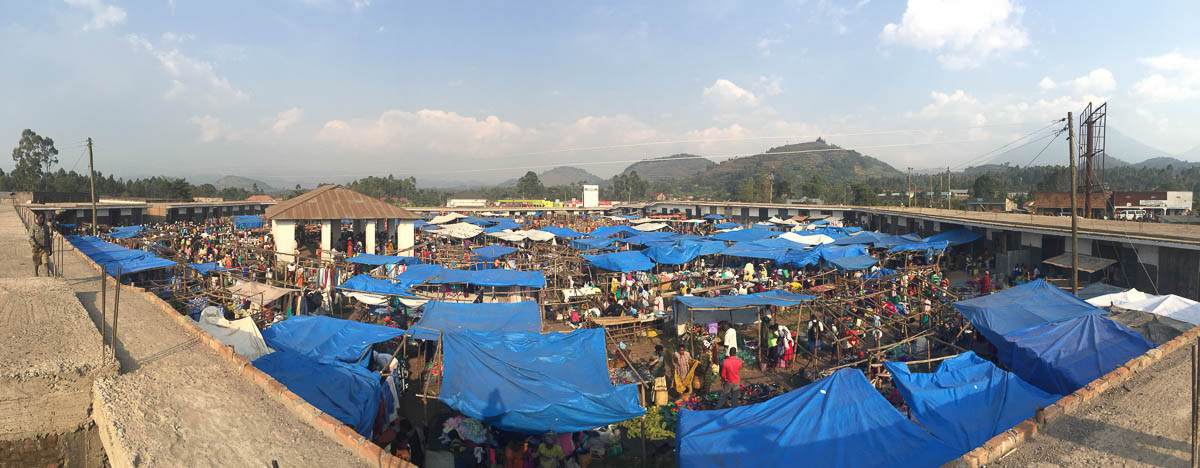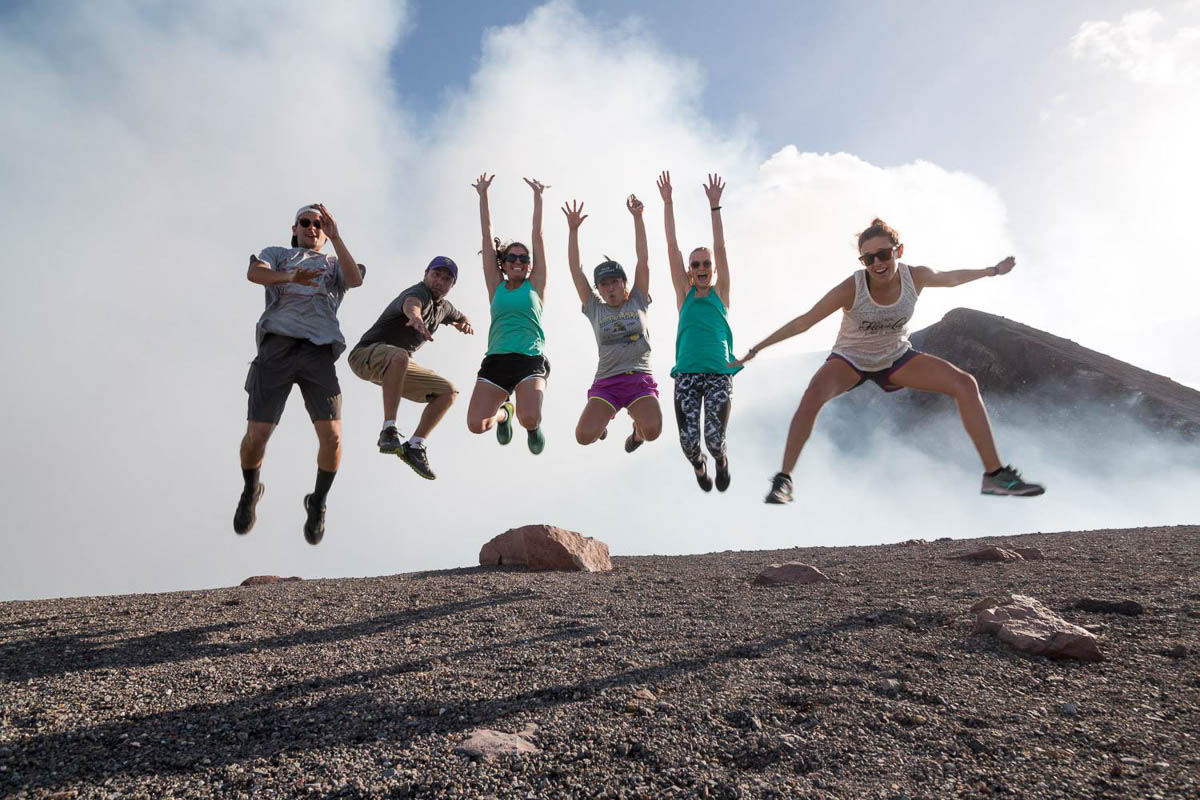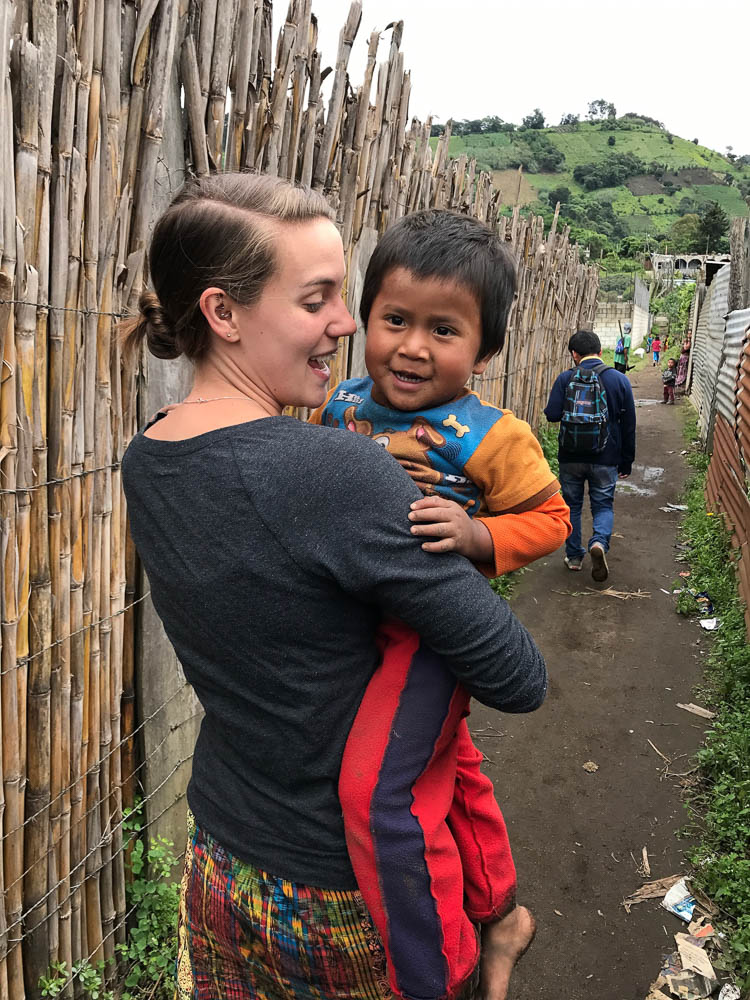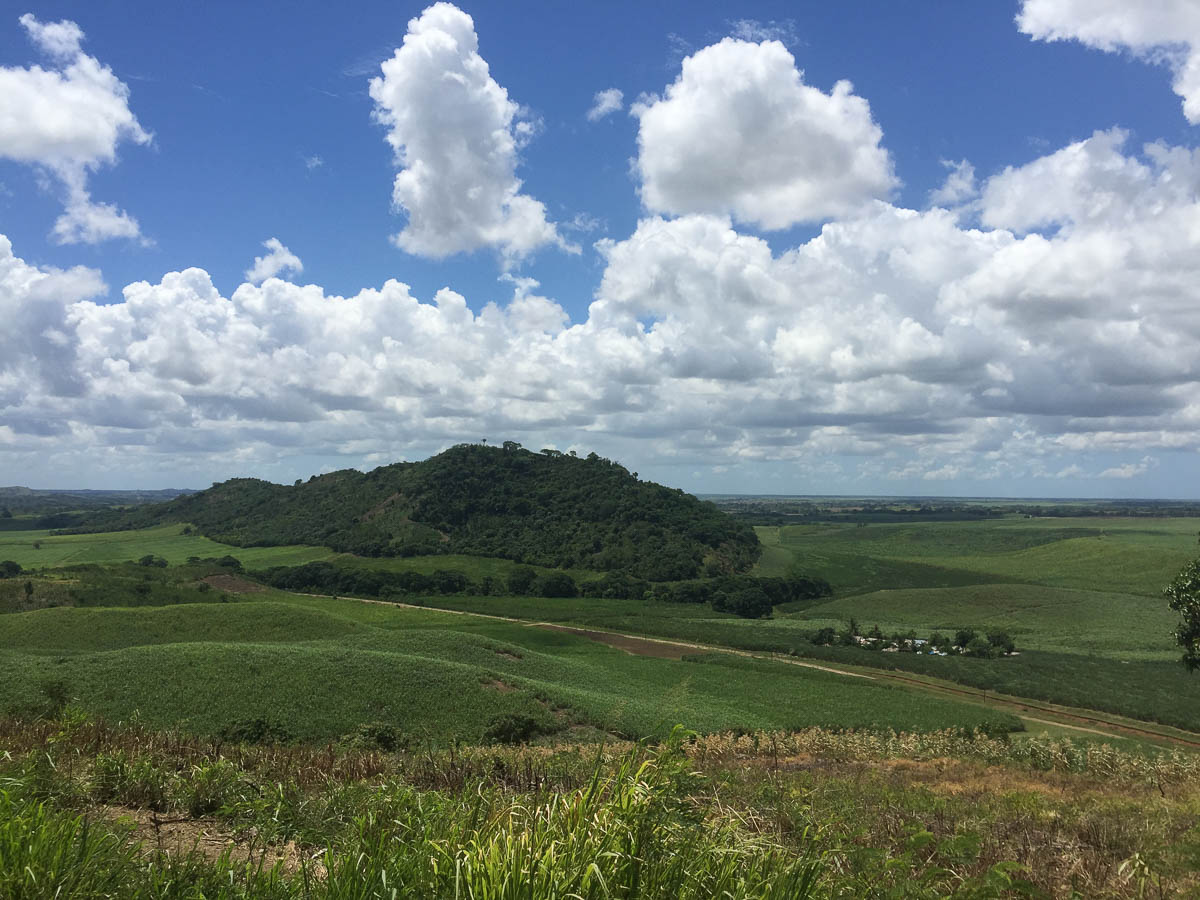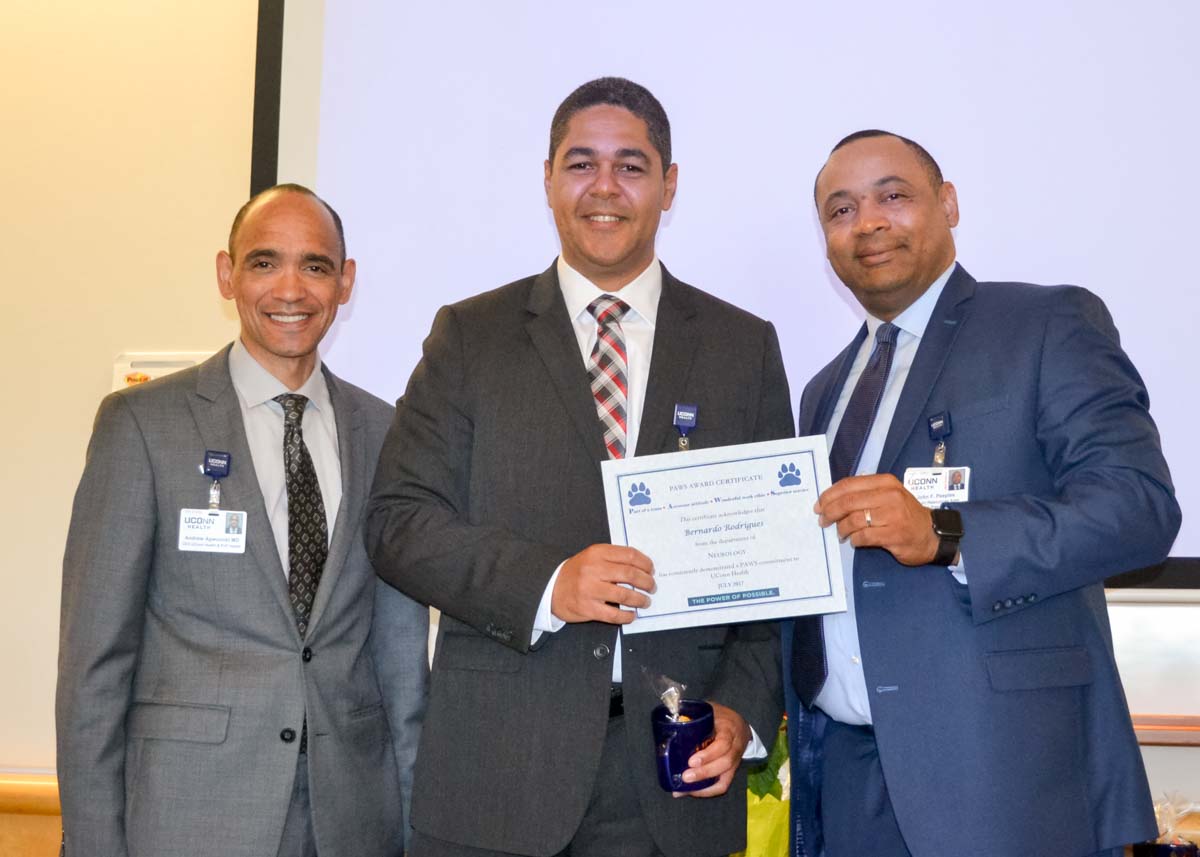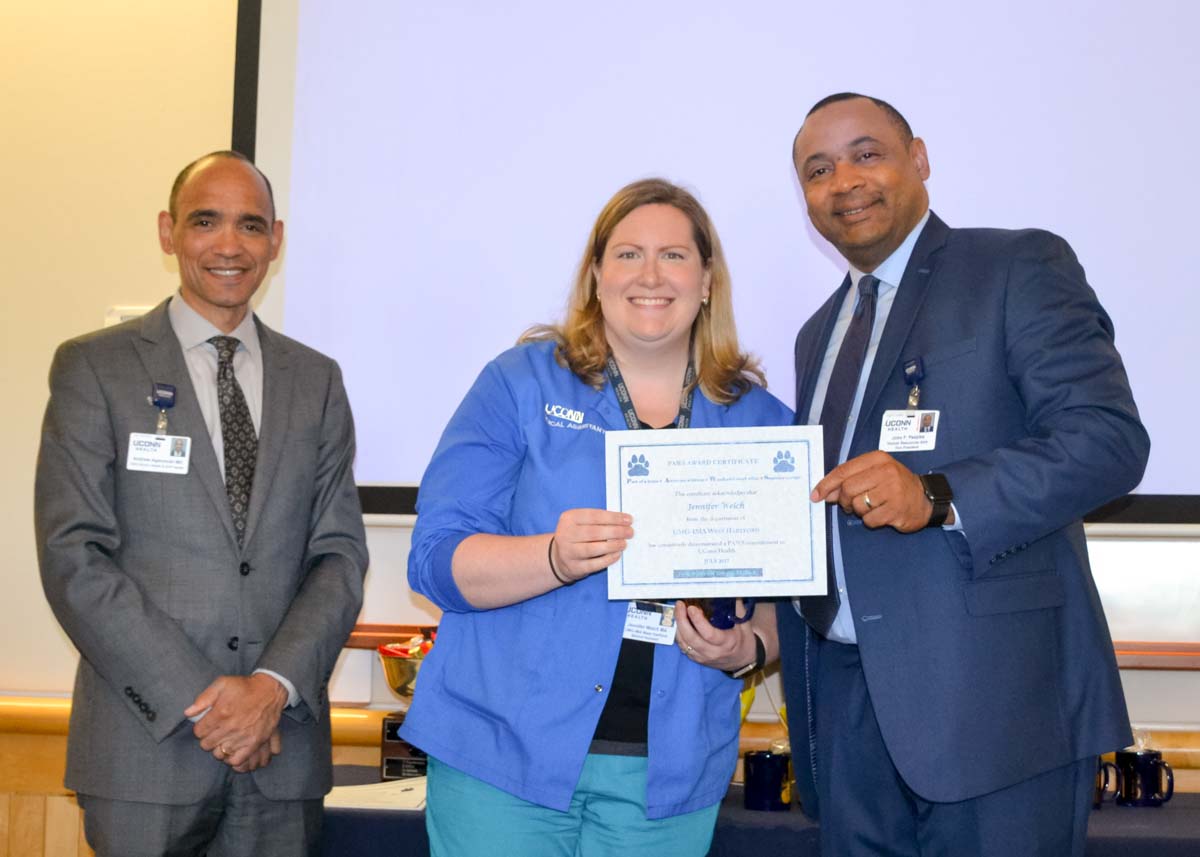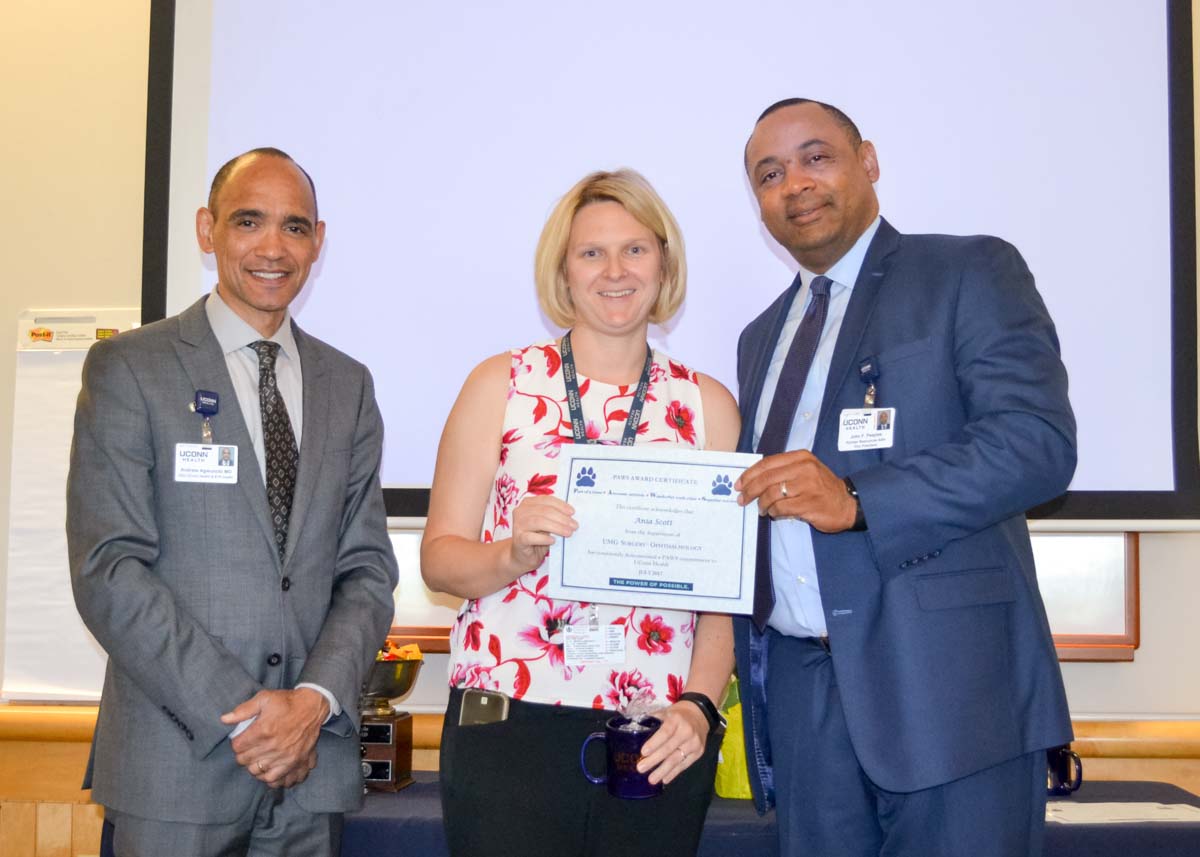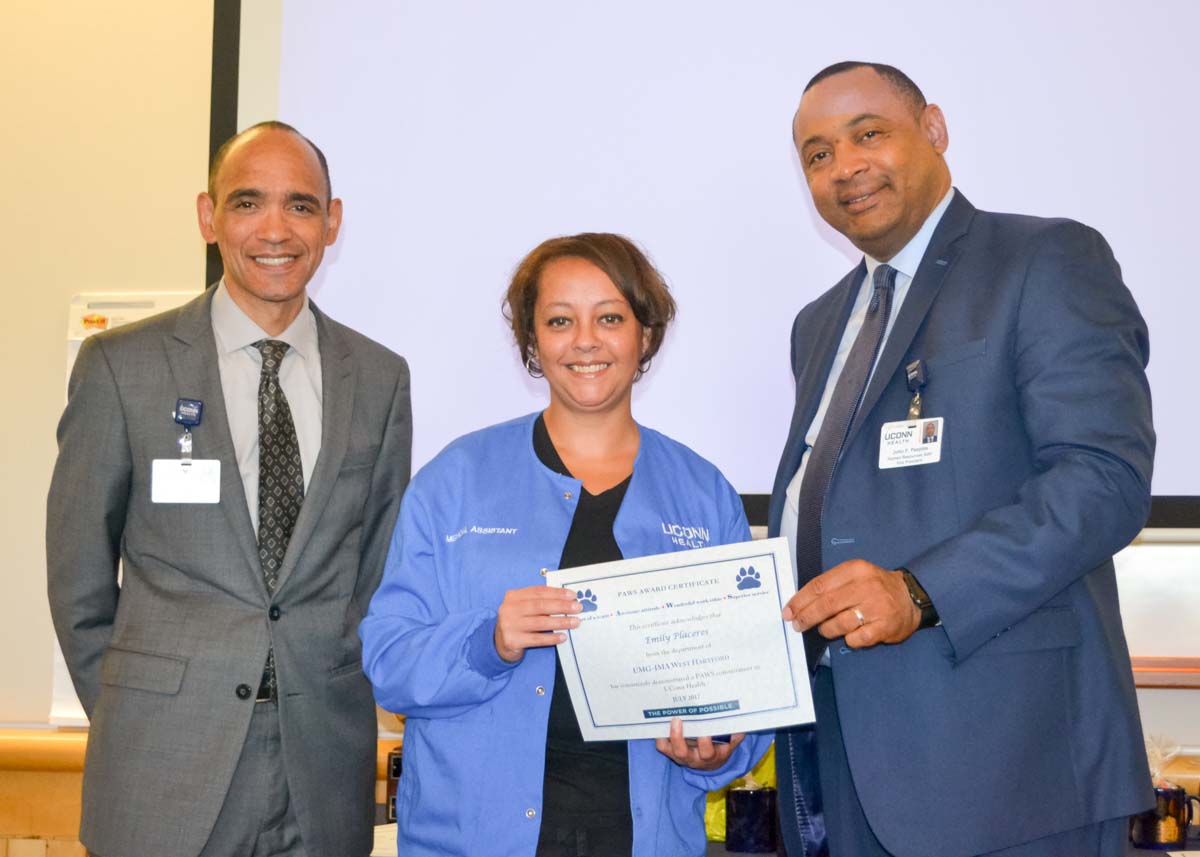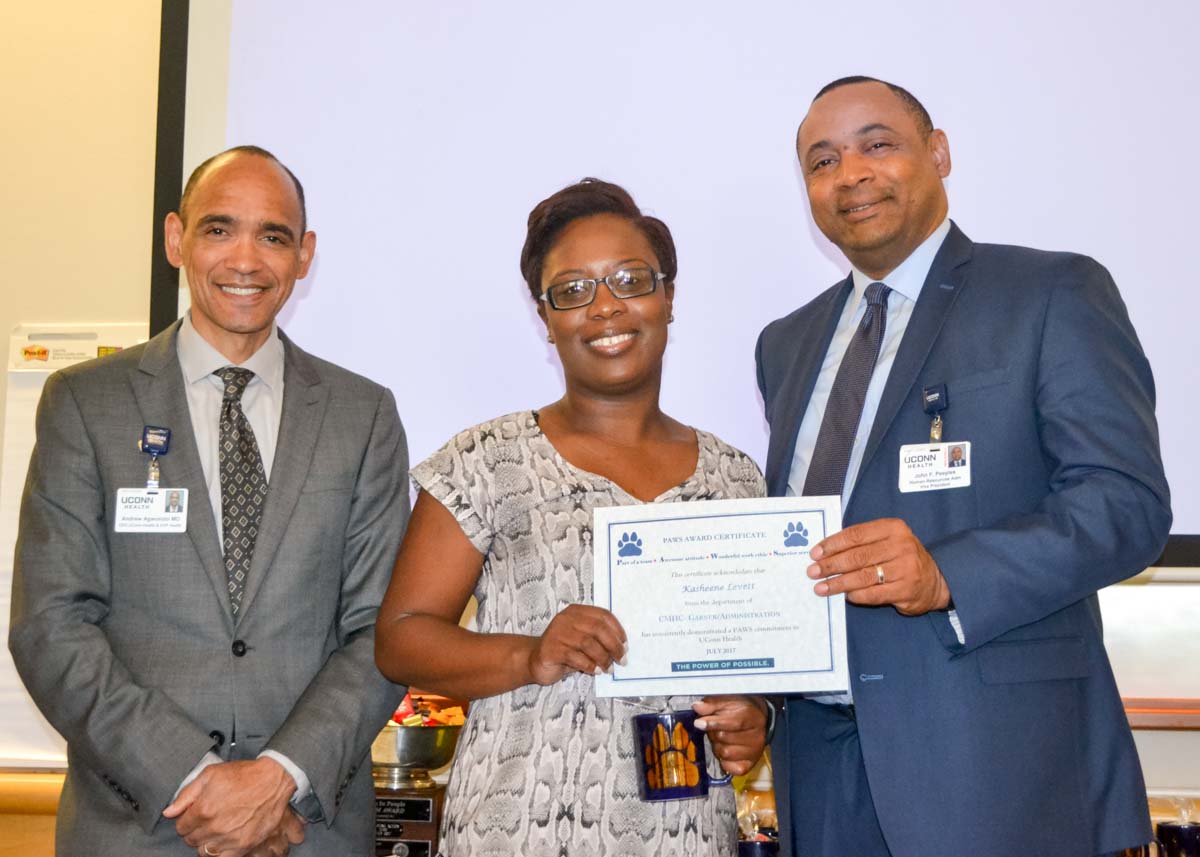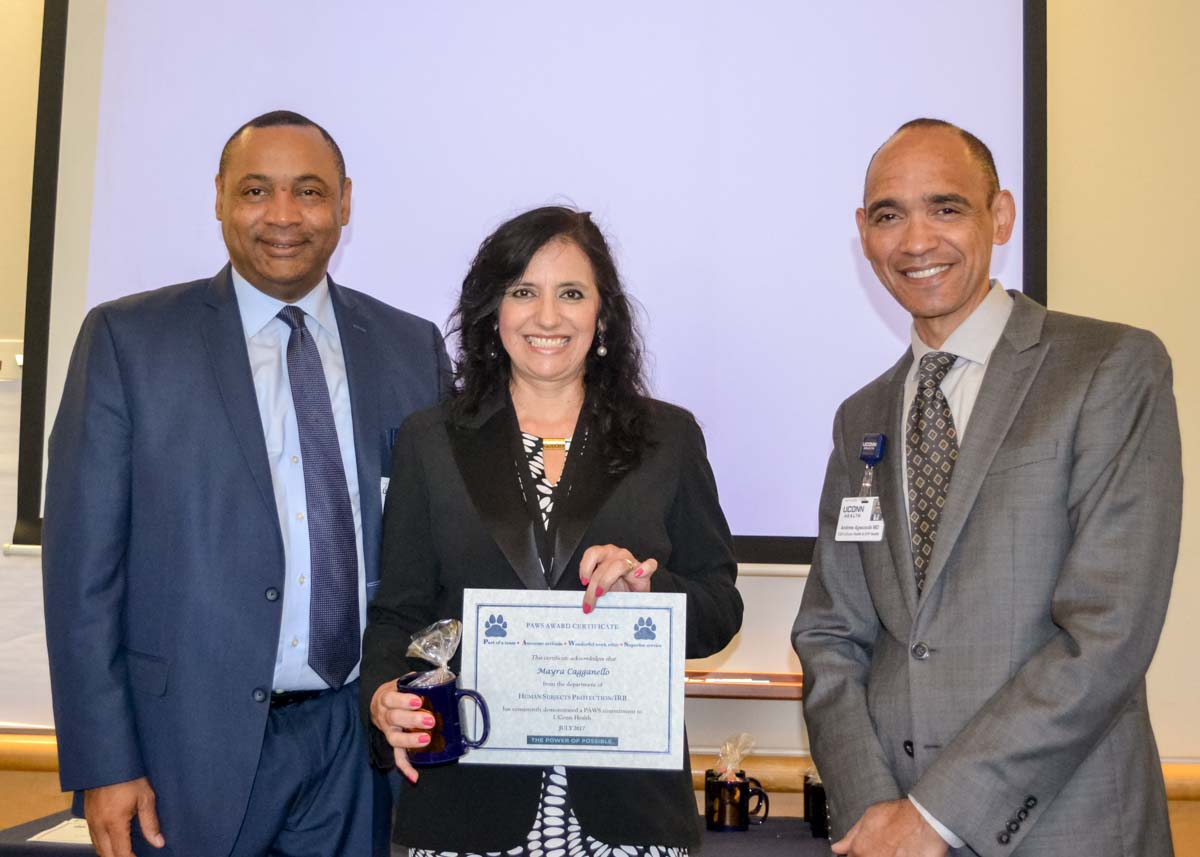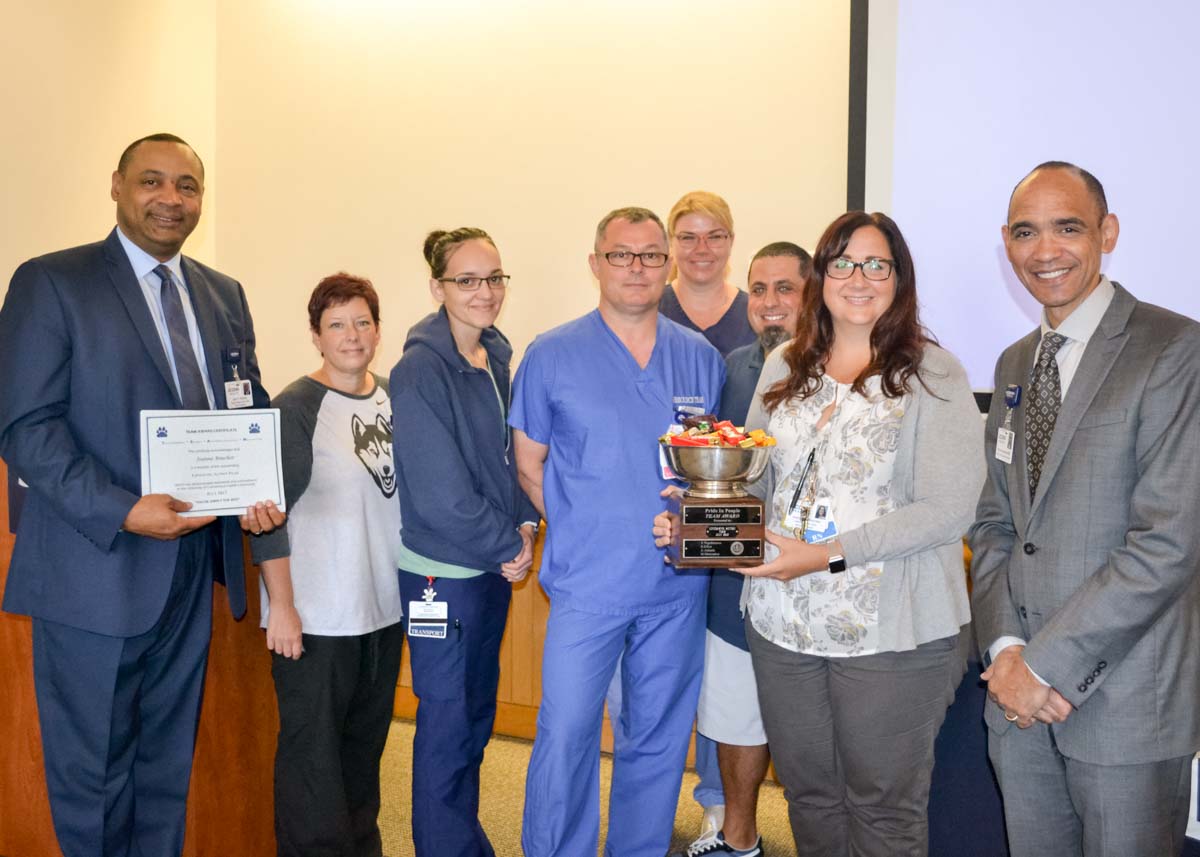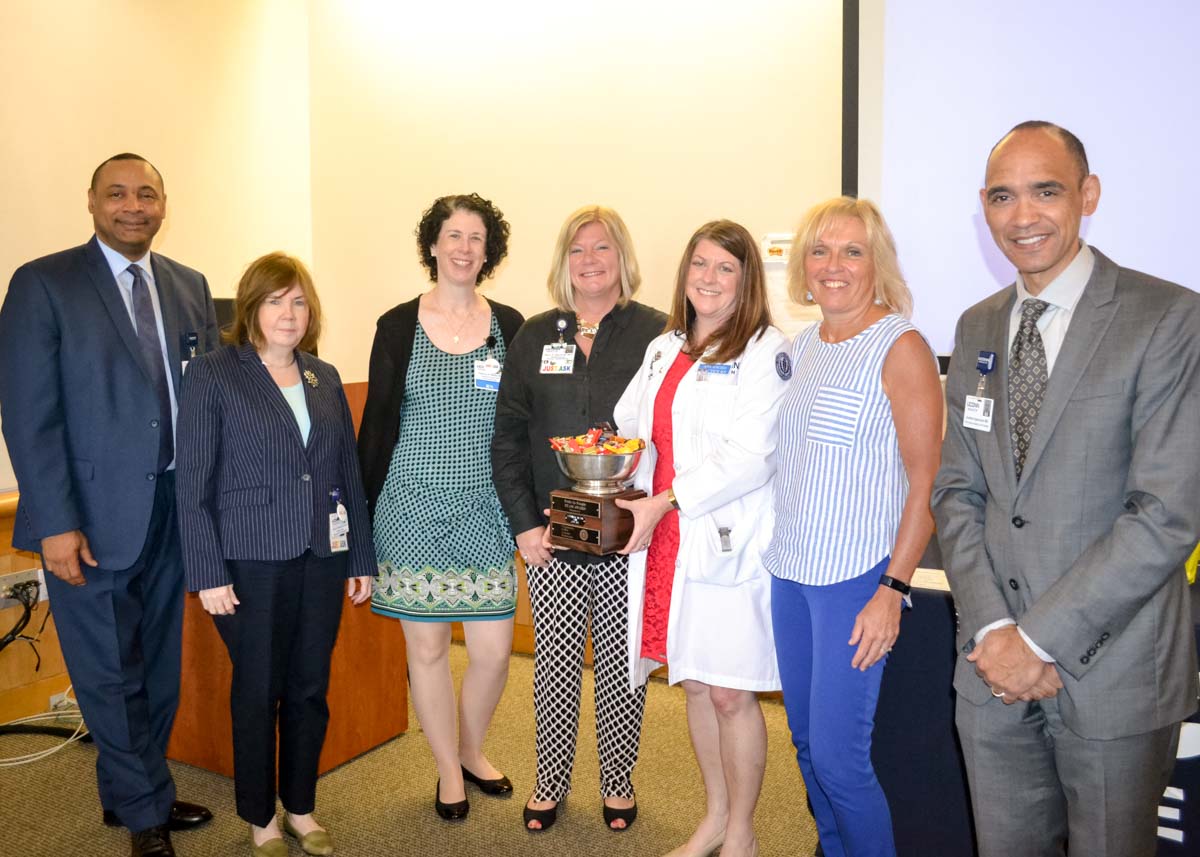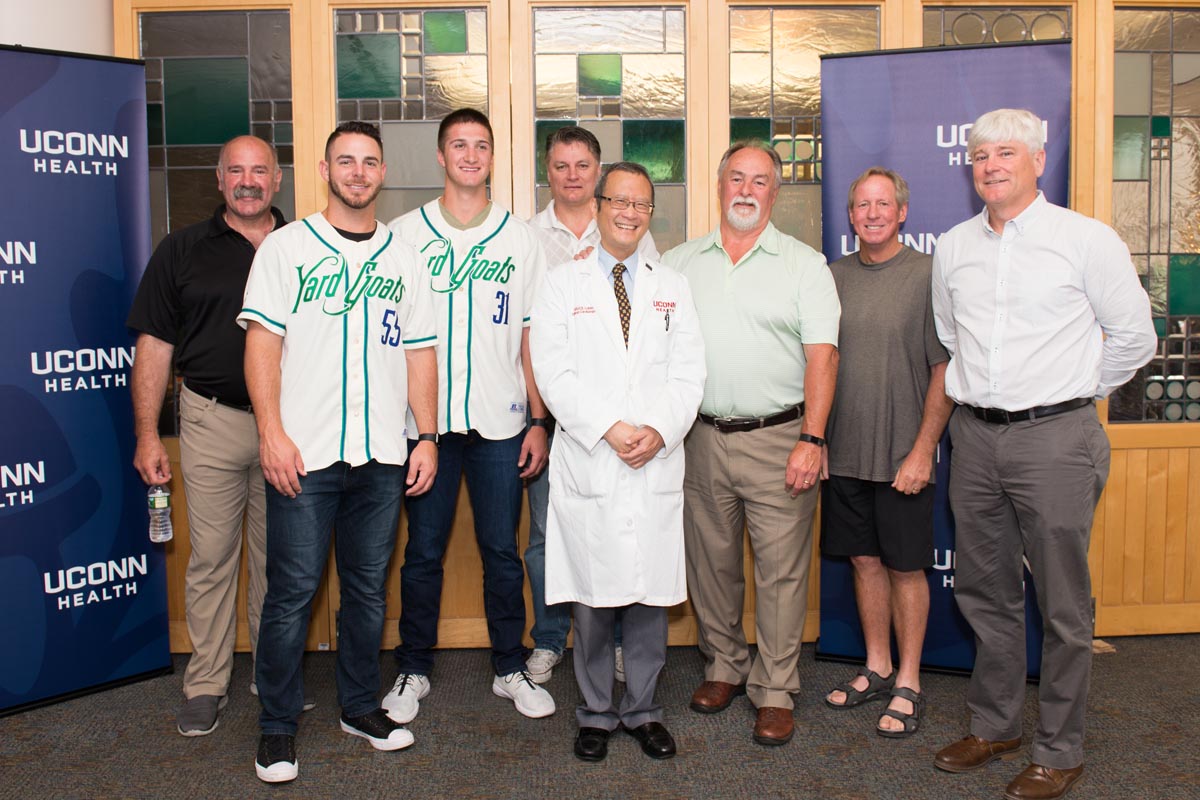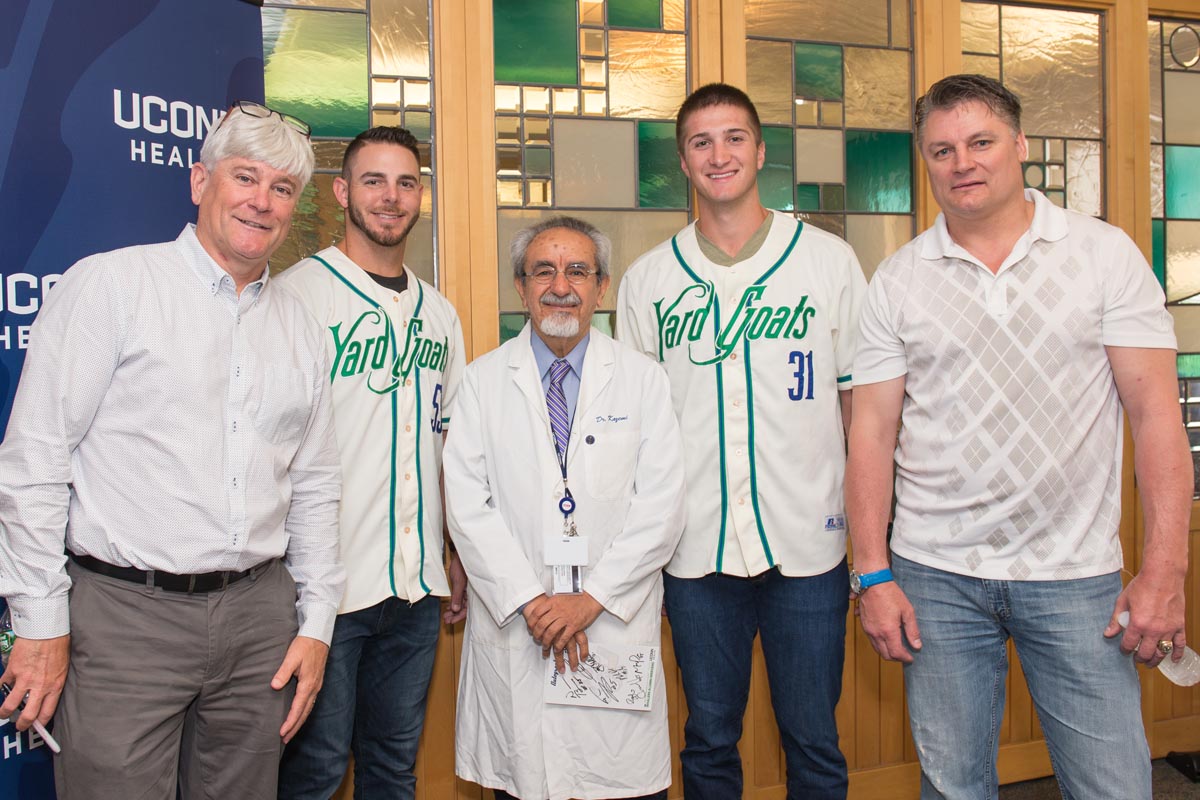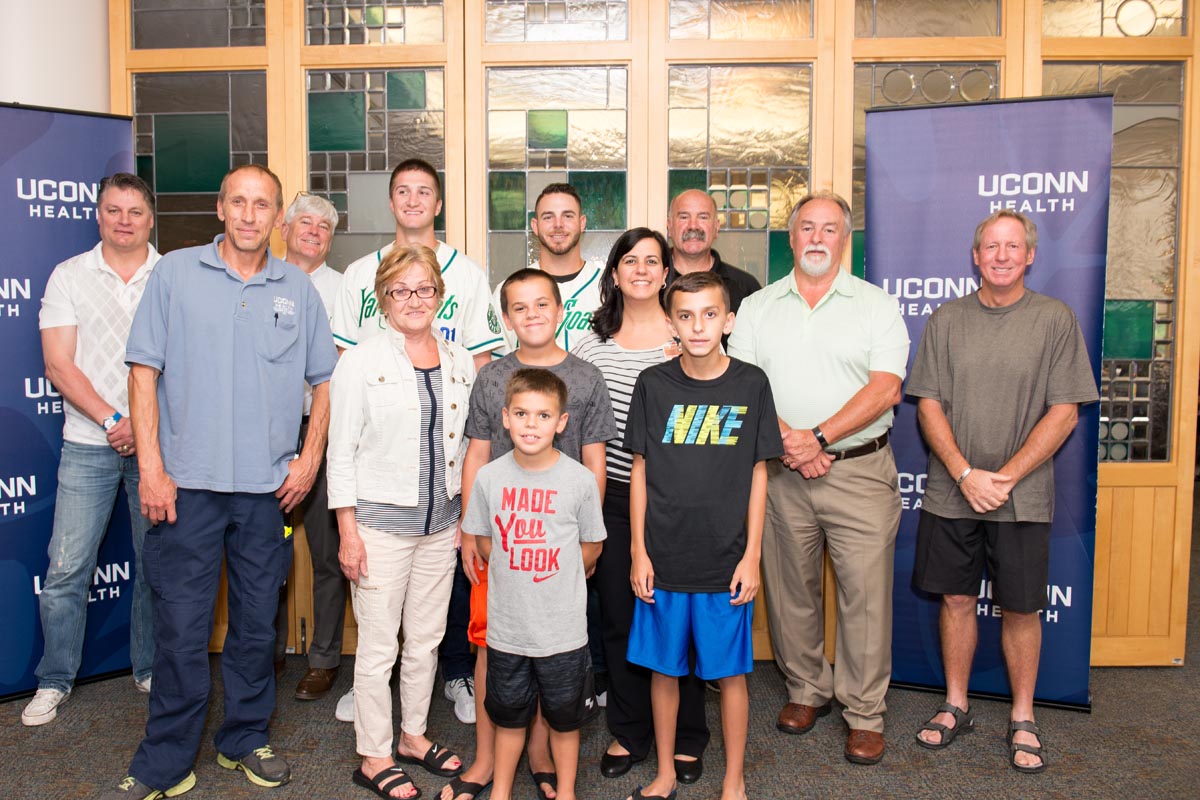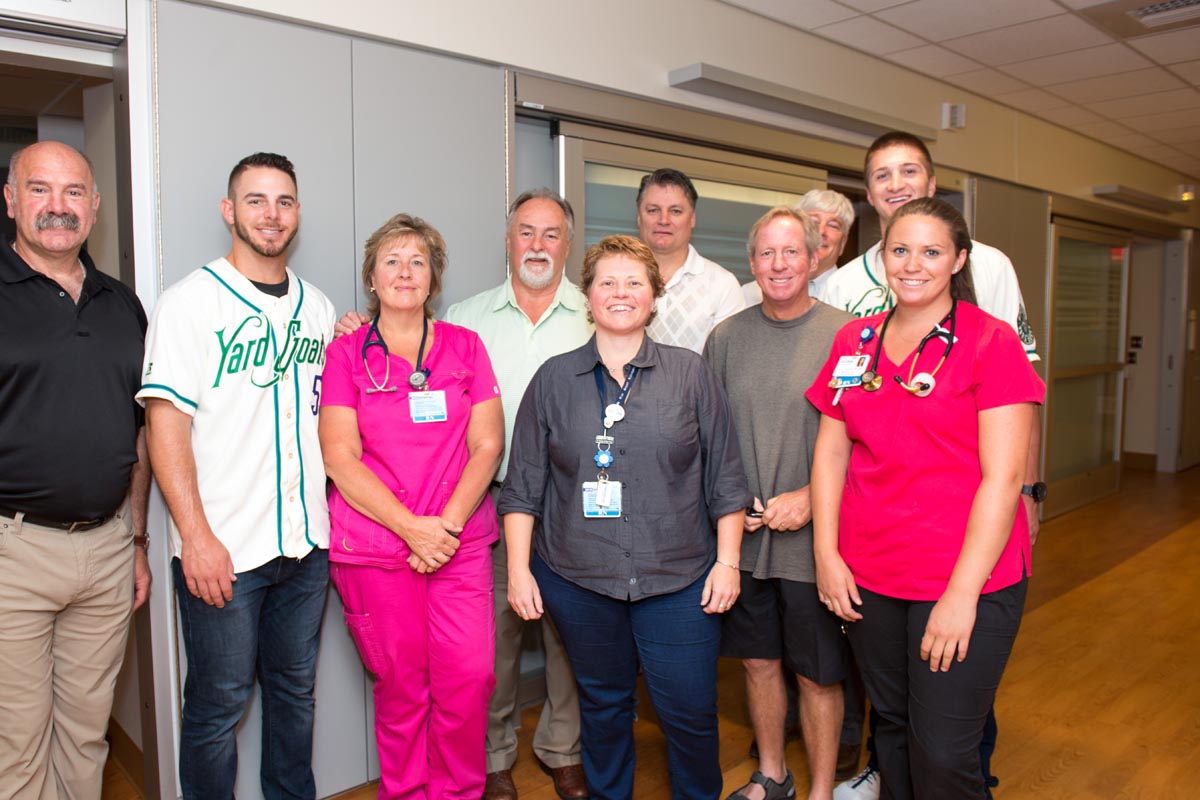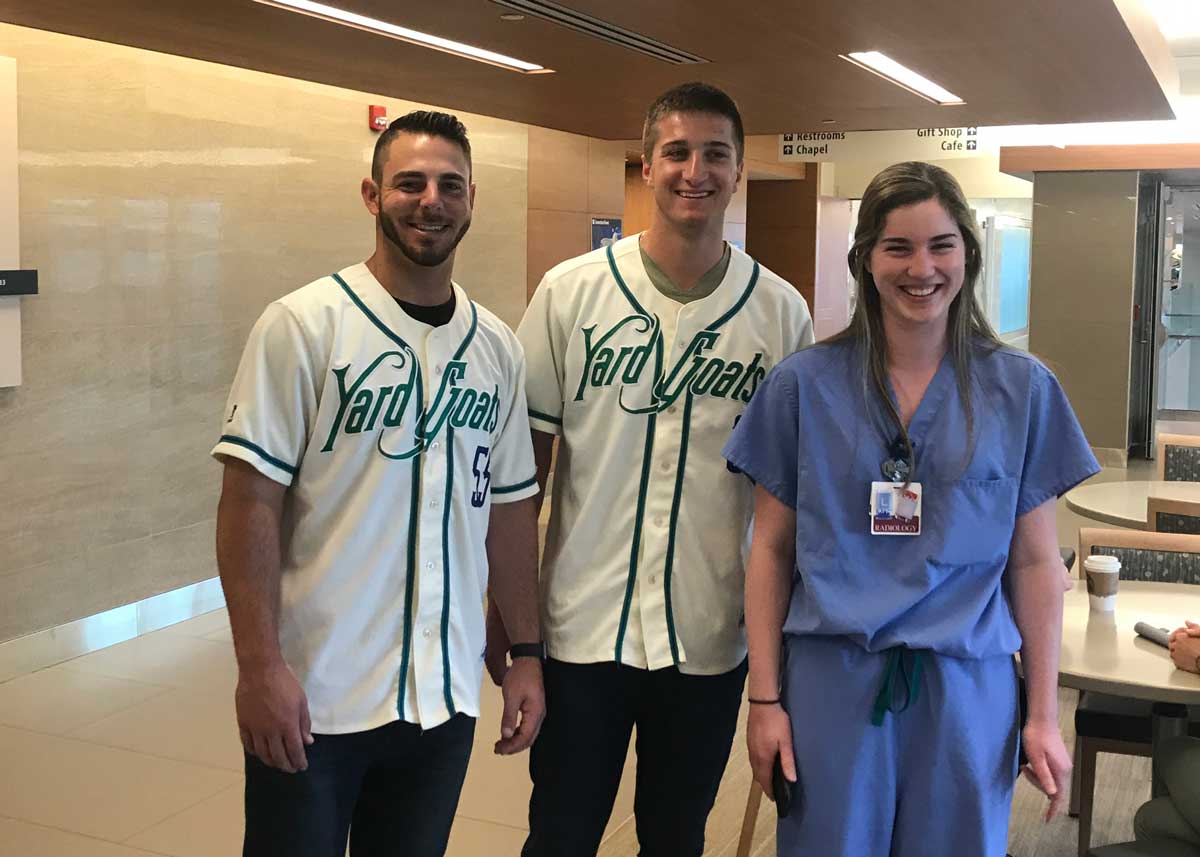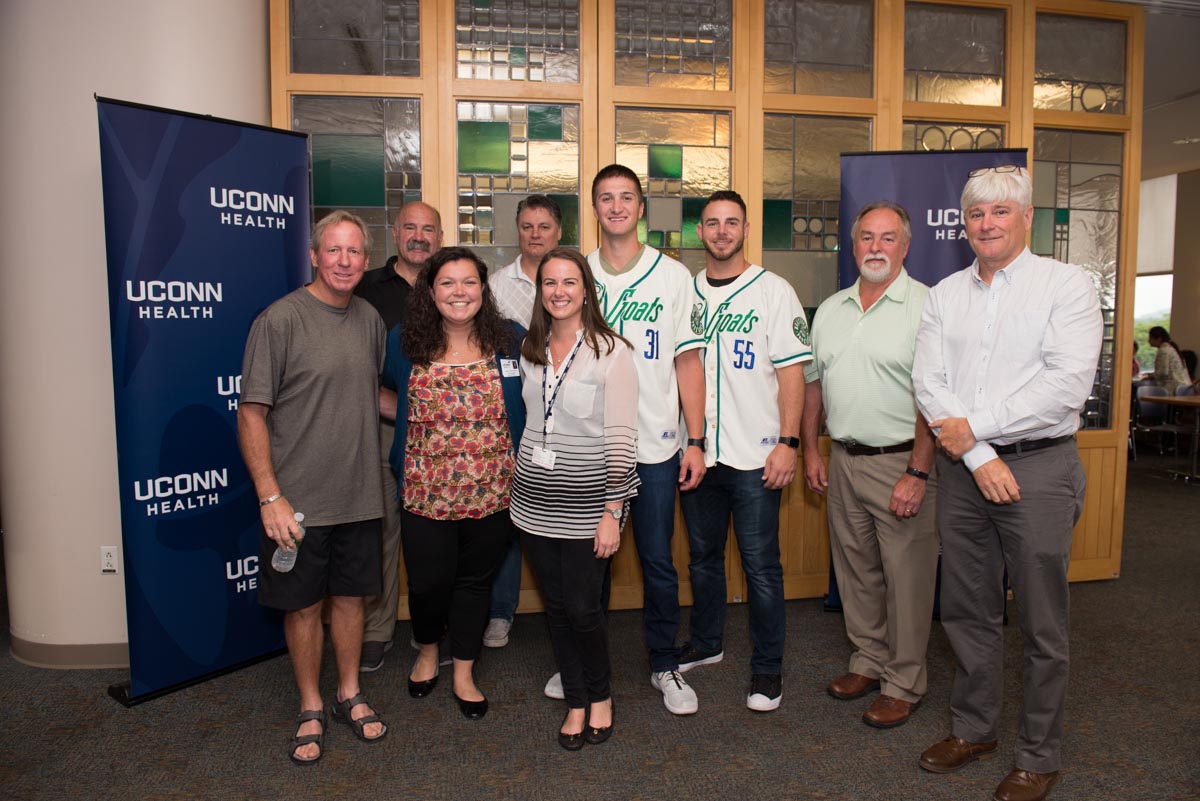Many of our UConn medical and dental students spent part of their summer abroad providing medical care to those with few resources and learning valuable lessons about human resilience. Last night, some of them gathered for a “Global and Community Health Homecoming” to share their stories — and pictures — with their classmates.
Pulse
Looking at Us: Dig This, Carol Underwood
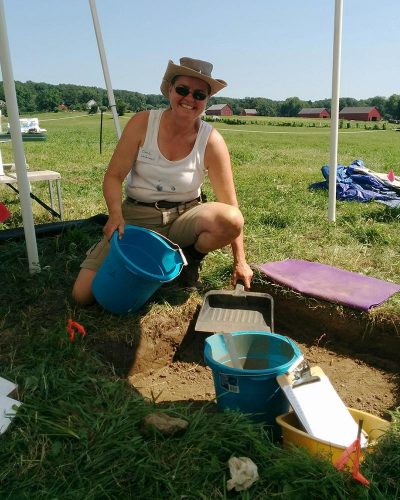
Carol Underwood spent a week this summer on an official dig with state archaeologist Brian Jones. Carol lives in Bloomfield and has been with UConn Health for five years. When she’s not unearthing artifacts, she’s working in the Information Technology Department as an application architect and Oracle database administrator. The official dig she participated in was at a large buried farm complex in Glastonbury associated with Lt. John Hollister of Glastonbury that dates back to the mid-17th century.
What did you find?
Artifacts like rusty iron nails, bits of brick, glass, bone, teeth, fish scales, charcoal, chert, flint, clay pipe stems and bowls, pottery both glazed and earthenware, snails. I was not lucky enough to find the native beads and points that were unearthed. I exposed a “feature” which was a large stain in the dirt 30 centimeters down that indicated a support post for the house had been there.
What is the significance?
This is arguably the most important historic period archaeological site to be identified in the state of Connecticut. The site documents an especially poorly understood period of colonial history as the first English settlers of the Connecticut River Valley adjusted to a new way of life.
How did you become interested and get involved?
I always liked dirt, digging, history and databases. All are good qualities to have in an archaeologist. Decades ago I wrote to then state archaeologist Nicholas Bellantoni about his work on vampires in New England. He wrote me back and invited me to come on a dig, so I had been thinking about this for a long time.
Carol Underwood
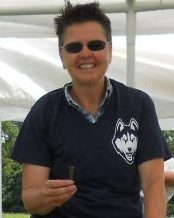 Favorite musician:
Favorite musician:
Dixie Chicks/Natalie Maines
Favorite place to visit:
Acadia National Park (Seawall, Thunder Hole)
Person you’d like to meet:
Former Alabama Gov. George C. Wallace. During his final years, he publicly recanted his racist views and asked for forgiveness from African Americans. I would like to talk to him about that process.
Favorite sports team
UConn women’s basketball
What was a typical day like?
Each day was a day of hard labor surrounded by beautiful farms and horses. I would arrive at the Park & Ride at 8:45 a.m. and meet up with other crew members. We would carpool to the farm, then stroll through the horse pasture down to the dig site. We erected a tent city to protect us from the sun. We would start right in digging our area that was carefully marked out. Precise levels of dirt were removed and each bucket sifted. Artifacts found were placed into plastic bags marking site, quadrant, quad, level and my initials. It was dig – sift, dig – sift cycle all day long till 3 p.m. If someone found a cool artifact we would do show and tell. I went home tired, dirty and exhilarated.
What surprised you on this dig?
Ground-penetrating radar (GPR) technology was used to find the original farmstead. The radar also showed three wigwams, which may be the first archaeological evidence of cohabitation between early colonists and Native Americans.
Also, one day, to my surprise, the now-retired Dr. Nicholas Bellantoni showed up. I told him about the letters we wrote to each other many years ago then said, “I’m here!” I got to work with Dr. Bellantoni and he was finding all the good stuff like native beads.
Learn more about the Connecticut Archaeology Center at www.cac.uconn.edu/osa.html.
Bruce Metz Named CIO
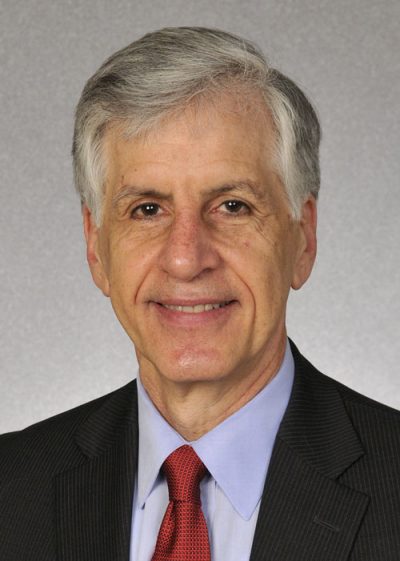 UConn Health welcomes Bruce Metz as chief information officer starting Sept. 11.
UConn Health welcomes Bruce Metz as chief information officer starting Sept. 11.
“UConn Health has a wealth of opportunity and extraordinary capabilities including possibilities presented by the one UConn model. I am very excited to be joining such a talented team and look forward to helping the organization achieve even greater levels of excellence in research, teaching, and clinical care by capitalizing on advances in technology,” said Metz.
With experience at academic institutions like Tufts, Rider, and Princeton, he has twice led large organizational electronic health record transformations, once at Thomas Jefferson in Philadelphia, and more recently bringing EPIC to Lahey Health in Burlington, Massachusetts where he served as senior vice president and chief information officer.
In this role, he will report to leadership both at the University and UConn Health.
“In our model, it’s essential to have someone with the kind of experience to navigate all the challenges and deliver that reliable, high-quality product for the thousands of users – staff and patients – who rely on it every day,” commented Dr. Andy Agwunobi, EVP, and CEO of UConn Health. “I am therefore extremely excited that Bruce will be joining us.”
“As the first UConn Health CIO under our one university movement, I know Bruce will help us find ways to work together, leverage learning, find opportunity and start us down a path where collaboration makes us stronger together than we could be independently,” said Michael Mundrane, Vice Provost and CIO, University of Connecticut.
Metz received a B.S. degree in industrial and management engineering from Columbia University, and an M.A. in organizational development and Ph.D. in applied psychology from New York University.
Metz assumes duties from Denise Purington who has acted as interim CIO since December. Denise will stay engaged as long as needed to support a smooth transition.
“UConn Health leadership is grateful to Denise for the leadership, perspective, and stability she brought to the organization under her leadership,” added Dr. Agwunobi.
HealthONE: 9 Months Away and Counting

The group tasked with implementing UConn Health’s new electronic medical record system, HealthONE, is preparing to start another major step.
The testing phase, which got underway in May, moves into the first of five rounds of integrated testing starting July 31. In the 18 weeks that follow, analysts will test “integrated scripts” to uncover potential defects. The scripts, which mimic current workflows, practices and processes, serve as a way to ensure processes within HealthONE’s clinical, patient access, and revenue cycle applications will work when the system goes live.
“It’s known as integrated testing because it verifies that workflows affecting multiple departments, applications or interfaces can be carried out successfully in HealthONE and across all the external systems we interface with,” says Bryan Kerr, interim assistant vice president for HealthONE.
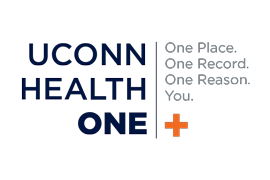
Bringing HealthONE online is a six-phase undertaking. Testing is the third, and longest, phase. Other types of testing already have started. The first round of what’s known as “end-user testing,” in which health care providers and other subject-matter experts try out the system and provide feedback, runs through next week. Testing is scheduled to run into next spring and overlap with the training phase.
“We are nine months away from go-live, and we’re right on track,” says Denise Purington, interim chief information officer. “We continue to receive satisfactory evaluations and are hitting critical milestones.”
HealthONE Training
Upcoming Information Sessions
Main Building
Food Court Lobby
- Tuesday, July 25
- Thursday, July 27
- Tuesday, Aug. 8
Outpatient Pavilion
5th Floor, Cafeteria
- Tuesday, July 25
- Thursday, July 27
- Tuesday, Aug. 8
- Thursday, Aug. 10
All times 11 a.m. to 1 p.m.
UConn Health gets a monthly progress report from the HealthONE vendor, Epic, which provides the software, training and support.
Looking Ahead
There will be information sessions about HealthONE training for inpatient and outpatient staff starting next week.
HealthONE is looking for staff with the appropriate skills to be a member of the HealthONE Credentialed Trainer group. More information about this role is available at one of the training information sessions or by emailing kirobinson@uchc.edu.
Additionally, a list of frequently asked questions on HealthONE training is now available.
The HealthONE website is being updated and will have more frequent and timely updates as the April 28, 2018, go-live date nears.
In the coming weeks, UConn Health IT staff will start installing computers, monitors, and other hardware in departments needing technology upgrades for HealthONE to work optimally. IT will work with managers on scheduling to minimize disruptions.
PAWS Award Winners July 2017
Vicky Aldrich, Department of Social Work
Mayra Cagganello, Human Subject Protection/IRB
Krystyna Dzierlatka, Surgery/Orthopaedics Unit
Sarah Heald, Medical/Surgical/Oncology Unit
Barbara Laskey, Dental Financial Services
Kasheene Levett, CMHC – Garner (Administration)
Emily Placeres, UMG – Internal Medicine Associates (West Hartford)
Dr. Bernardo Rodrigues, Neurology
Ania Scott, UMG – Surgery/Ophthalmology
Christine Urban, UMG – Storrs (Administration)
Jennifer Welch, UMG – Internal Medicine Associate (West Hartford)
| TEAMS | ||||
| VAE GROUP | MEDICAL RESPONSE TEAM | |||
| Jill Alsgaard | Intensive Care Unit | Laura Contakis | Intensive Care Unit | |
| Janet Annesi | Respiratory Therapy | Jessica Demarest | Intermediate Unit | |
| Rachel Crosby | Epidemiology | Jaroslaw Dybinski | Support Float Pool | |
| Debapriya Datta | Pulmonary | Susada Inthavong | Medicine 3 Unit | |
| Kara Dazkevich | Intensive Care Unit | Ana Miranda | Nursing Transportation | |
| Michelle Delayo | Intensive Care Unit | Aadhar Patil, M.D. | Resident | |
| Nancy Dupont | Epidemiology | David Policastro | Intermediate Unit | |
| Giselle Funchion | Strategic Proj. & Clinical Sys. | Sofia Talaniec | Intermediate Unit | |
| Aubrey Hepner | Intensive Care Unit | |||
| Gillian Kuszewski | Pharmacy | |||
| Julie Laflamme | JDH – Organization Staff Dev | |||
| Sandra Pilares | Strategic Proj & Clinical Sys | |||
| Caryl Ryan | Nursing Administration | |||
| Kimberly Silverman | Rehab Services – Outpatient | |||
| Marie Sudsbury | Epidemiology | |||
Former Hartford Whalers and Hartford Yard Goats Visit UConn Health
To kick off Hartford Whalers’ Alumni Weekend last Friday, Yard Goats pitchers Ryan Castellani and Matt Pierpont, with former Hartford Whalers Bob Crawford, Mike Rogers, Grant Jennings, Dave Babych, and Norm Barnes visited hospital patients and also took the time to visit staff. Photos by Tina Encarnacion.
Meet the IT/HealthONE Management Team
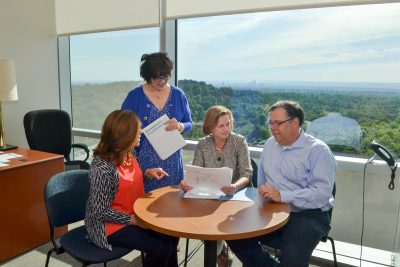
An essential part of HealthONE’s electronic health record (EHR) implementation process, set to go live on April 28, 2018, is the ongoing work of UConn Health IT Department’s two assistant vice presidents and director, and four HealthONE project directors in collaboration with many analysts, architects and engineers.
This management team works closely with the HealthONE leadership team of Denise Purington, BSN, interim CIO; Dr. Dirk Stanley, CMIO; and newly arrived Bryan Kerr, HealthONE’s interim assistant vice president.
The managers oversee the planning, implementation and management process of various information technology needs and HealthONE’s specific EPIC applications.
We would like to introduce you to the IT and HealthONE management team and hear what they think are the ultimate perks and benefits of UConn Health’s upcoming EHR system.
Robert Darby, AVP of IT Strategic Projects and Clinical Systems manages the HealthONE’s team charged with helping to ensure data from existing systems and those systems that are not scheduled to be replaced by EPIC are incorporated into the HealthONE system and available to clinicians and support staff within the HealthONE applications. He also oversees the teams who are developing the necessary operational reports and analytic and business intelligence tools that will be used to manage the business unit, support quality reporting and business and clinical transformation. Some of the tools they use from EPIC include Bridges, Data Courier and Cogito. In addition to the HealthONE team, Darby manages the Clinical Application Support Team, Project Managers and Clinical Informatics Teams that support all non-HealthONE applications and clinical implementations that play a vital role in the HealthONE implementation project. Along with over 9 years at UConn Health he has 20 years of health care IT experience in implementation, support, management and integration of clinical systems and environments.
Best perk of HealthONE? Moving from a best of breed (many individual systems) systems approach to a single unified UConn Health enterprise solution.
Number one benefit of HealthONE for UConn Health? Gaining access to information stored within a single database will allow us to act quicker to provider better care to our patients as well as better quality reporting for our patient population and research partners.
Michael Catrini, AVP of Enterprise Technology Systems manages the HealthONE team responsible for connecting our data center to the EPIC data center in Wisconsin. He also manages the team that will ensure the correct HealthONE applications and equipment are installed on thousands of end user devices across the organization. He brings over 20 years of clinical IT experience to the project, including two previous enterprise EHR installations.
Best perk? Reducing the number of applications needed to treat patients.
Number one benefit? Speed of access to the patient data. The users will be able to quickly reach the correct data at the correct time during patient care.
Carrie Gray, director of Information Security oversees the HealthONE Security Coordinators responsible for building, maintaining and educating users about the security of the HealthONE system. Additionally, she manages the Information Security team responsible for establishing and coordinating the development, management and implementation of information security technologies, policies, standards and procedures for protecting UConn Health’s confidential data and critical systems.
Best perk? The ability to access multiple functions with a single user ID.
Number one benefit? A streamlined approach to granting access to the system based on a user’s responsibilities.
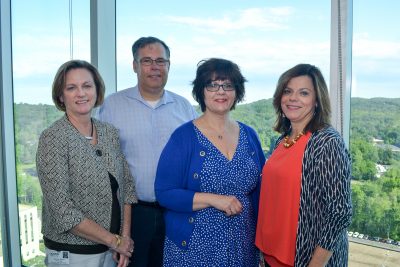
Liz Zibell, RN, MSN oversees HealthONE’s Clinical applications named ASAP (emergency department), Willow (pharmacy), Stork (obstetrics and labor and delivery) along with the Orders, Clinical Documentation and Infection Control modules and functions. For this role she brings more than 11 years of EHR experience. She has previously managed the clinical informatics teams at UConn Health and served as a clinical transformation specialist for the Cerner Corporation. Her nursing background includes experience in the NICU, pediatrics, home health, and clinical research settings.
Best perk? The strength of the clinical team and their skill sets which will enhance the HealthONE application.
Number one benefit? A safer and more robust data environment for our patients and staff. We will all get there together.
Carolyn Orrell, MBA is responsible for HealthONE’s Access and Revenue Cycle applications which are named Cadence (scheduling), Grand Central (transport, bed planning), Prelude (registration), Resolute HB and PB (hospital billing and professional billing and claims), and HIM/Identity (Health Information Management). She has over 20 years of experience in healthcare IT. She has served in various project management and leadership roles for the implementation of clinical and revenue cycle financial systems and EHRs. In addition, she also attained her Six Sigma Green Belt from the Juran Institute.
Best perk? The new functionality and streamlined processes.
Number one benefit? The EPIC functionality and new third party solutions that will benefit our patients, providers, and staff.
Kathy Noel leads the Ambulatory applications for HealthONE. Her scope of responsibility spans physician office workflows in Ambulatory and Orthopedics, Healthy Planet (population health), MyChart and CareLink (patient and community engagement applications), Canto and Haiku (mobility applications), and Research Studies. She began her IT healthcare journey 28 years ago at the Hospital of St. Raphael, then St. Francis, and arrived nearly 8 years ago at UConn Health as a project manager for the rollout of NextGen. She has managed the development of many clinical applications across the continuum with insight into workflows of many hospital departments.
Best perk? The integration the HealthONE system will provide to connect all the dots between our currently separate systems and the ‘one-stop-shopping’ advantages this gives to our clinicians and our patients.
Number one benefit? HealthONE will provide us with transparency and reporting that has previously been unattainable.
Christopher M. Carroll, MBA, PMP directs HealthONE’s Ancillary applications. He oversees the applications called Beacon (oncology), Beaker (lab), Radiant (radiology and cardiology) and the Optime/Anesthesia (operating rooms and anesthesia) modules for HealthONE. Chris has been with UConn Health’s IT department for the last 7 years. Prior to HealthONE, he was project manager of numerous initiatives including Banner and NextGen. Chris has experience as a consultant, as well as holding various positions across healthcare, insurance, higher education, administrative and financial organizations.
Best perk? The integration of so much clinical information in one place will streamline many workflows.
Number one benefit? It will readily provide patient information to the fingertips of those providing patient care and to those ancillary areas performing tests and procedures.
We encourage you to reach out to any of these leaders with questions or concerns. We also want to thank all the IT and HealthONE team members who are working to deliver the HealthONE system by April 2018 and all those in the organization who have participated in design sessions. Without everyone’s involvement we couldn’t have gotten as far as we have today.
Active Shooter Awareness
UConn Health leadership and staff participated on June 7 in a U.S. Department of Homeland Security FEMA led tabletop drill exercise to further enhance its response to an emergency situation such as an active shooter.
“As a campus we need to make sure we are always as prepared as possible for a natural or man-made disaster such as workplace violence that can occur at any time or anywhere. This is why we drill regularly at UConn Health,” says Bryan Gran, the new emergency management specialist at UConn Health who led the interactive discussion-based exercise.
Institutional representatives hailed from across the departments of fire, police, hospital, facilities, communications, nutrition and emergency departments at UConn Health. In addition, representatives participated from the Connecticut State Division of Emergency Management and Homeland Security, the West Hartford Fire Department and seven other institutions from across the country.
“Very few people are trained to know what to do for their personal protection in an active shooter situation,” says Joe Curreri, chief of UConn Health Police. This is why since 2014 UConn Health has made active shooter awareness and education mandatory for all new employees and students during their onboarding orientation.
Curreri added, “Education about active shooters is not designed to alarm employees, but to make them more aware of the possibility of this type of event occurring whether at work or in their day-to-day lives and to make them more aware of their response options should they find themselves in this situation.”
In fact, a study performed by Johns Hopkins Office of Critical Event Preparedness found that there were more than 150 hospital-related shootings nationwide from 2000 to 2011, in more than 40 states, and with more than 235 people killed or injured. Unfortunately, hospital related shootings have been on the rise since the study was completed.
Should you ever find yourself in harm’s way take proactive steps to protect yourself and help save more lives.
Important Tips to Remember:
- Be aware: To help prevent an event’s occurrence, make sure to report any suspicious warning signs of a potential active shooter or violent person to the Police immediately by calling 9-1-1.
- Know the Emergency Codes: Remember to wear your UConn Health identification card at all times so you can quickly refer to the back of it for any announced emergency hospital codes. A ‘Silver’ alert stands for an active weapon threat.
- Remember to ‘Run, Hide, Fight’: These three action may make the difference in your survival during an active shooter situation.) Run: Try to escape or evacuate the active shooter’s area if you can to safety. Only you are important so leave any belongings behind. As you run verbally alert others to prevent their harm and call 9-1-1 once you are safe.
2.) Hide: If you can’t escape the active shooter’s area, find a place to hide behind a locked or barricaded door or even behind a large object. Remain quiet and remember to silence your phone.
3.) Fight: As a last resort, if you can’t run or hide, fight with aggression against the active shooter assailant whether alone or as a group.
For more tips on emergency preparedness, visit: https://health.uconn.edu/police/crime-prevention/.
Second Project Search Graduation Slated June 2
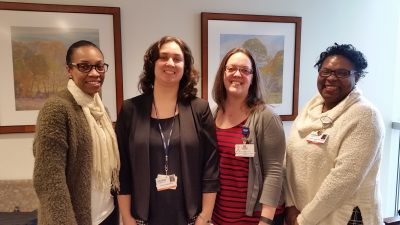
Nine interns with Project SEARCH, an innovative program designed to prepare young adults with intellectual and developmental disabilities (IDD) for careers, not just jobs, will be graduating from the program at a special “bridge ceremony” on Friday, June 2.
Project SEARCH is the most successful youth transition program in the nation at placing young adults with IDD in gainful employment. Connecticut’s only program, a partnership between Favarh – The Arc of the Farmington Valley – and UConn Health, is located at the UConn Health Farmington campus. At the program, young people with IDD are demonstrating that when given the opportunity and proper supports to succeed, they can and do exceed, often beyond our preconceived notions of what is possible.
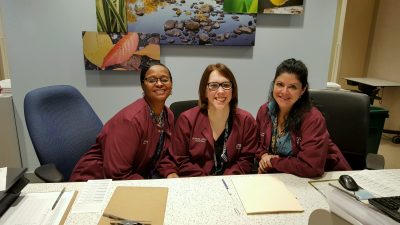
Project SEARCH was founded in 1996 at the Cincinnati Children’s Hospital. The program is a one-year, unpaid internship program designed for students either in their last year of high school or graduates in their first year out of school.
The largest private employer in Canton with 275 employees, Favarh was founded in 1958 by eight local families who all wanted a better life for their children with intellectual disabilities. Today, Favarh is a local chapter of the Arc, the world’s largest community-based organization for people with intellectual, physical and developmental disabilities. Favarh supports more than 350 children, young adults, adults, seniors and families throughout the Greater Farmington Valley area and beyond.
Media contact: Bill Neagus, wneagus@favarh.org
Husky Heroes Raise Funds for Cancer Research and Patient Services
Team UConn Health Husky Heroes has been busy this spring sponsoring and fundraising two important local events: Connecticut Breast Health Initiative’s 2017 Race in the Park on May 13 in New Britain and the American Cancer Society’s Relay For Life of Farmington on May 20. Donations for both events totaled $6,447 raised by 54 team members made up of survivors, staff, caregivers, families, and friends.
The Race in the Park raised $3,069 to fund important breast cancer research and education projects in the state. Participants stopping at the UConn Health table were introduced to the Beekley Imaging Center, received information about the patient-centered Breast Program at the Carole and Ray Neag Comprehensive Cancer Center, and breast cancer survivors had the opportunity to consider participation in a CT BHI grant funded research project. Team members spent a great deal of time interacting with other participants at the event and one of the highlights was when Julia Tannenbaum, daughter of Dr. Susan Tannenbaum, read her poem “Pink Is More Than A Color” at the Survivor Breakfast.
At Relay for Life, $3,378 was raised which will help the American Cancer Society fund groundbreaking cancer research, crucial patient care services, and prevention and early detection programs. This is the most that the team has ever raised for Relay. The Farmington Valley Relay exceeded their goal in raising almost $480,000. Team members dropped by throughout the day to walk laps, participate in activities, and show their spirit at the UConn tent. Dr. Upendra Hegde gave an inspirational speech at opening ceremonies.
